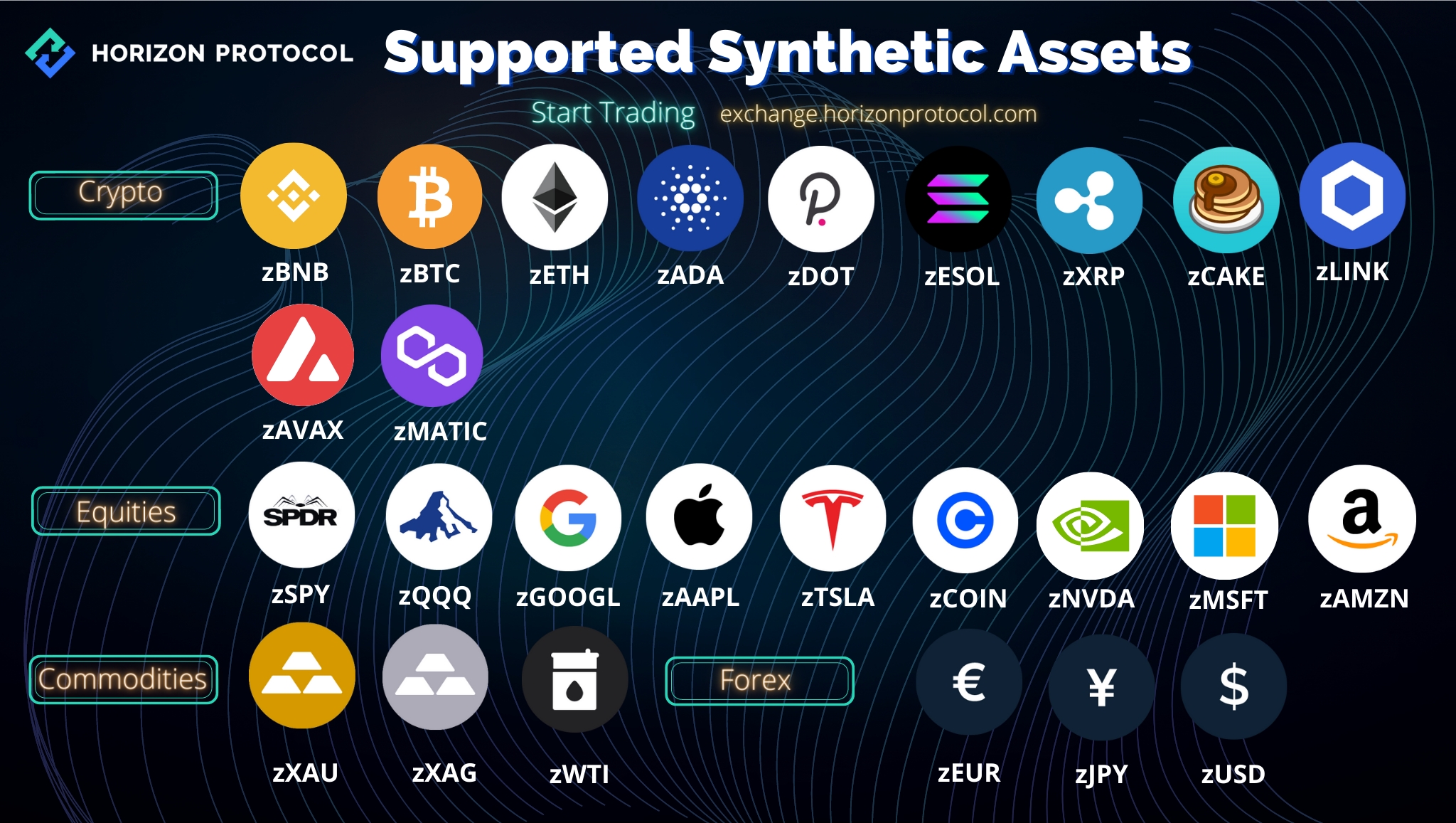Synthetic Assets - zAssets
Horizon Protocol bridges the products of traditional financial markets and brings it into the world of decentralized finance (DeFi) in the form of synthetic assets.
Understanding Synthetic Assets
Synthetic assets are tokenized derivatives, essentially contracts that mirror the value of an underlying asset without the need for actual ownership of that asset.
These synthetic assets, referred to as "zAssets" on Horizon Protocol, offer a broad spectrum of possibilities. They can emulate various types of assets, including:
Stocks: A synthetic stock replicates the price fluctuations of traditional equities.
Cryptocurrencies: Synthetic tokens can track the price movements of cryptocurrencies like Bitcoin, BNB or Ethereum.
Commodities: They can represent commodities such as gold, silver or oil.
Fiat Currencies: Synthetic versions of fiat currencies, like the US dollar or Euro, provide stable options for traders.
NFTs: Even the uniqueness of non-fungible tokens (NFTs) can be simulated through synthetic assets.
Baskets of Assets: Synthetics can combine multiple assets into one, resembling index funds or exchange-traded funds (ETFs).
Horizon Protocol's pioneering "zAsset" is "zUSD," a stablecoin pegged to the value of the US Dollar. It functions as the primary currency for trading other zAssets on the Horizon Protocol platform.
Accessibility and Opportunities
Since synthetic assets are tokenized, they offer ease of access and introduce an additional layer of DeFi products. This accessibility unlocks various yield-generating opportunities, potentially democratizing access to assets that may not have been readily available otherwise.
The Potential of Synthetic Assets
DeFi and synthetic assets signify a fundamental change in derivatives. Traditional derivatives serve three core purposes: hedging, leverage, or price speculation.
With the global derivatives market estimated at over $1 quadrillion, decentralized solutions offer the potential for broader access to global opportunities and encourage the development of innovative derivative products.
Creating Synthetic Assets on Horizon Protocol
To make a decentralized synthetic assets market possible, Horizon Protocol establishes a system for providing collateral to back the issuance of “zAssets”. The collateral is in the form of Horizon Protocol’s native token, “HZN”, which is staked to make sure there is sufficient value underlying all “zAssets”. Rewards are then paid out to all users who have staked HZN to help support the market.
For stability, incentives are in place to make sure stakers actively participate in the staking process to balance out the collateral-to-asset ratio.
zAssets
Synthetic Assets produced on Horizon Protocol are called zAssets. For example, Bitcoin (BTC) is referred to as zBTC, and Apple (APPL) stock is called zAPPL.

Horizon Protocol smart contracts always values any non-zUSD zAsset at the current market rate of its underlying asset through the use of Chainlink Oracles, a decentralized price feed that mimics the price of the underlying asset. This guarantees that the value of a zAsset such as zBTC will always be valued and traded at the current market price of BTC within the Horizon Protocol ecosystem. All non-zUSD zAssets are overcollateralized at the same rate as zUSD and are backstopped by HZN stakers, who incur the risk of the fluctuating rates of all zAssets in the protocol and are incentivized to maintain a healthy collateralization ratio.
zUSD: The Core zAsset
zUSD is the primary zAsset on Horizon Protocol, serving as a stablecoin pegged to the US Dollar. It plays a vital role as the evaluation currency for all synthetic assets produced on Horizon Protocol. zUSD is the key entry point for exposure to over 25 synthetic assets representing the real economy across various market sectors. It is also the primary margin currency for trading on Horizon Protocol’s perpetual futures exchange.
Horizon Protocol guarantees that zUSD maintains a $1.00 value during minting or burning by requiring stakers to deposit HZN tokens, worth 6x the freshly minted zUSD, as collateral. Unlike algorithmic stable coins, this ensures the stability of zUSD's peg to the dollar within the Horizon Protocol ecosystem. While the value of zUSD on the open market may fluctuate based on supply and demand, it creates arbitrage opportunities between the open market and Horizon Protocol.
zUSD also facilitates the trading of other zAssets available on Horizon Protocol’s trading page. For a full overview of available zAssets, please refer to the image above.
As per HIP-8, the open market zUSD liquidity pool currently exists and is incentivized on Wombat Exchange’s multi-chain stableswap.
zBNB: A Secondary On-and-Off Ramp
zBNB is one of the 25+ synthetic assets backed by Horizon Protocol. Recognizing the advantages of BNB's liquidity and its status as the native coin on the BNB Chain, we have taken steps to enhance accessibility. For this reason, we have created a secondary on- and off-ramp, allowing users to easily acquire zAssets. You can obtain zBNB by swapping regular BNB for it on Wombat Exchange's multi-chain stableswap.
zBNB's value remains pegged to regular BNB through Chainlink Oracles, ensuring that it accurately reflects the current market price. This secondary on- and off-ramp enables non-protocol participants to access and arbitrage zAssets without needing to collateralize them through staking.
Like zUSD, the value of zBNB on the open market may fluctuate, creating arbitrage opportunities for users to profit between the open market and Horizon Protocol.
As per HIP-8, the open market zBNB liquidity pool exists and is incentivized on Wombat Exchange’s multi-chain stableswap.